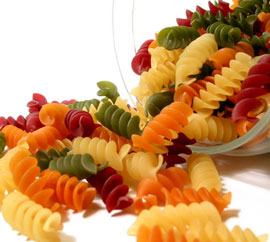Rotini
 |
Rotini, the popular salad pasta, is also terrific for baking because it is firm and has deep grooves for “hoarding” sauce.
|
The shape allows sauces, cheeses, and meats to nest in between each ridge. When cooked al dente, then baked, it can hold up to heavy and bold textures. It’s a widespread favorite – second only to spaghetti- with kids because of the twirly shape.
Varieties
Rotini is packaged plain (light yellow) or as a colorful garden variety that includes spinach, tomato, and carrot flavors.
Organic, gluten-free, whole-wheat, multi-grain, and reduced carbohydrate products are also available in most regions.
Buying Tips
Regular pastas are generally made with 100 percent durum semolina flour.
If you are looking for organic or whole-wheat products, read the label. Some of them incorporate small amounts of semolina, which improves the taste but makes the “natural” claim a bit misleading.
Storage Tips
As with all dried pastas, rotini will remain usable for a very long time. Check occasionally for possible – but rare - pest infestations.
Refrigerate cooked rotini and use within 3-4 days. You can also freeze it in a casserole for an easy make-ahead meal.
Usage Tips
Contrary to popular belief, it is not a good idea to add oil to prevent sticking. This coats the pasta and repels sauces or other ingredients.
Rotini is versatile and can accompany a wide range of dish whether they contain tomatoes, salad oils, or dairy products.
To make 4 cups cooked, you’ll need about 1 cup dry.
Substitution Tips
Penne pasta will maintain the same degree of firmness in most dishes.
Try one of our favorite rotini recipes:
Pasta Salad for a Crowd
Cheddar Pasta And Vegetables
Crispy Chili Twists





